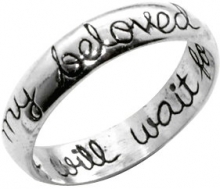This is an old revision of this page, as edited by Surv1v4l1st (talk | contribs) at 20:07, 10 June 2020 (→See also: Reordered). The present address (URL) is a permanent link to this revision, which may differ significantly from the current revision.
Revision as of 20:07, 10 June 2020 by Surv1v4l1st (talk | contribs) (→See also: Reordered)(diff) ← Previous revision | Latest revision (diff) | Newer revision → (diff) This article is about the object. For the electronic band, see Purity Ring (band).
Purity rings (also known as promise rings, abstinence rings, or chastity rings) are worn as a sign of chastity.
History
In the 1990s, in the United States, Evangelical organizations promoting virginity pledges and virginity before marriage, like True Love Waits and Silver Ring Thing, used the purity ring as a symbol of commitment. Wearing a purity ring is typically accompanied by a religious vow to practice abstinence until marriage. Chastity rings are part of the abstinence-only sex education movement and are intended to act as a physical reminder of their chastity vow.
Supporters
Several individuals and organizations advocate or have advocated for purity rings. Entries with a dagger (†) no longer advocate for the use of purity rings.
Musicians
- BarlowGirl †
- Demi Lovato †
- Group 1 Crew
- Miley Cyrus †
- Jessica Simpson
- Jonas Brothers †
- Jordin Sparks
- Selena Gomez †
- Stacie Orrico
Organizations
- Eu Escolhi Esperar (from Brazil)
- Promise Keepers
- TrueGirl (formerly Secret Keeper Girl)
- True Love Waits
- Unaltered (formerly Silver Ring Thing)
Criticism
David Bario of the Columbia News Service wrote:
Under the Bush administration, organizations that promote abstinence and encourage teens to sign virginity pledges or wear purity rings have received federal grants. The Silver Ring Thing, a subsidiary of a Pennsylvania evangelical church, has received more than $1 million from the government to promote abstinence and to sell its rings in the United States and abroad.
In 2005 the ACLU of Massachusetts brought charges against this decision, alleging that the Silver Ring program did not ensure its secularity and hence was ineligible for federal funding due to the Establishment Clause of the First Amendment.
See also
References
- Kathleen J. Fitzgerald, Kandice L. Grossman, Sociology of Sexualities, SAGE Publications, USA, 2017, p. 166
- "Teen Pledges Barely Cut STD Rates, Study Says". washingtonpost.com. 2005-03-19. Retrieved 2011-12-11.
- ^ Stephanie Rosenbloom (2005-12-08). "A Ring That Says No, Not Yet". Nytimes.com. Retrieved 2014-05-01.
- "Vernacular Abstinence". Practical Matters Journal. 2001-09-11. Retrieved 2011-12-11.
- "9 Celebrities Who've Worn Purity Rings". The Huffington Post. 2 July 2013. Retrieved 19 June 2014.
Believe it or not, wearing a purity ring was once a thing Miley Cyrus strongly believed in. Of course, the former Disney star wasn't alone in her conviction in waiting until marriage to have sex. In the past decade, scores of teen stars have talked about their pledge to abstinence by wearing it on their finger, from Jessica Simpson to the Jonas Brothers.
- "Power to the pure: Rutland Herald Online". Rutlandherald.com. 2005-03-29. Archived from the original on 2014-02-22. Retrieved 2011-12-11.